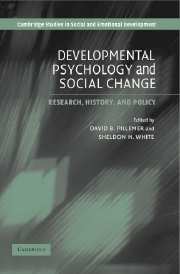Book contents
- Frontmatter
- Contents
- Preface
- List of Contributors
- Introduction: What Kind of Science Is Developmental Psychology?
- Part One The Developing Child: Global and Historical Perspectives
- Part Two Designing Child and Family Policies
- 4 The Effects of Welfare Reform and Poverty Policies on Children and Families
- 5 The Disconnect between Research and Policy on Child Care
- 6 Child Development and Child-Care Policy: Modest Impacts
- Part Three Designing Child Health Policies
- Part Four Designing Effective Learning Environments for Children and Adolescents
- Index
- References
5 - The Disconnect between Research and Policy on Child Care
Published online by Cambridge University Press: 03 December 2009
- Frontmatter
- Contents
- Preface
- List of Contributors
- Introduction: What Kind of Science Is Developmental Psychology?
- Part One The Developing Child: Global and Historical Perspectives
- Part Two Designing Child and Family Policies
- 4 The Effects of Welfare Reform and Poverty Policies on Children and Families
- 5 The Disconnect between Research and Policy on Child Care
- 6 Child Development and Child-Care Policy: Modest Impacts
- Part Three Designing Child Health Policies
- Part Four Designing Effective Learning Environments for Children and Adolescents
- Index
- References
Summary
Research and policy on child care have developed along parallel tracks. Their influence on each other has been modest, despite the shared historical context in which each has evolved. This stands in stark contrast to Head Start (Zigler & Valentine, 1979; Zigler & Muenchow, 1992), a product of the 1960s and the War on Poverty, in which policymakers engaged researchers in a variety of roles, from designers to evaluators. Today, these roles have converged into what White and Phillips characterize as “a virtual industry of Head Start research,” an industry that continues to be closely aligned with the policy community surrounding the program (2001, p. 83). The origins of modern-day child-care policy and research can also be traced back to the mid-1960s, when maternal employment and child-care usage began their steep upward trajectories. Why have research and policy on child care remained separate endeavors? Why has the relation between them evolved so differently from that between research and policy on Head Start? Can we hope for greater convergence in the years ahead?
To explore these questions about the disconnect between research and policy on child care, we begin by acknowledging the differing ways in which scientists and politicians think about child care. We then offer brief histories of child-care policy and research, which illustrate the mismatch between the central concerns and incentives guiding these two “distinct cultures,” described by Shonkoff (2000). Next, we apply the roles for developmentalists outlined by White and Phillips (2001) for Head Start to child care.
- Type
- Chapter
- Information
- Developmental Psychology and Social ChangeResearch, History and Policy, pp. 104 - 139Publisher: Cambridge University PressPrint publication year: 2005



